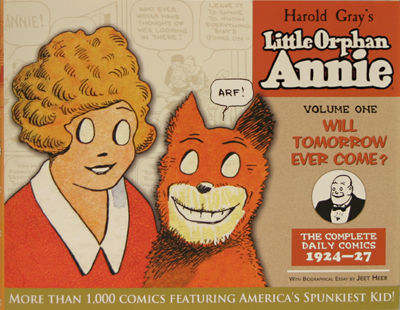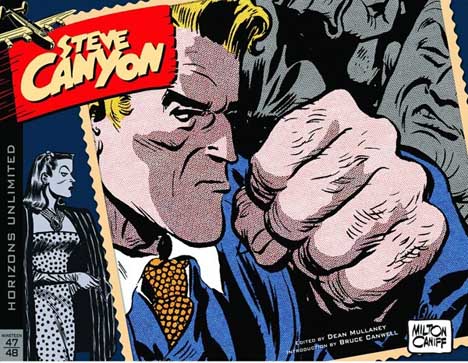
Editor’s Note: In recent years, we have observed many times that we are now living in the Golden Age of newspaper comic strip reprints. When columnist and critic Mark Squirek suggested a feature on the topic, we jumped at it. Here are his thoughts.
By Mark Squirek
There has never been a better time to be a fan of newspaper comic strips. Well known titles such as Gasoline Alley, Tarzan, Mickey Mouse, Peanuts, Little Orphan Annie, Blondie Dick Tracy and Pogo are always going to find an audience. But today’s reprint publishers are just as concerned with obscure strips such as Mike Hammer, Baron Bean, Barnaby, Willie and Joe, King Aroo, Bringing Up Father, Buz Sawyer and many others. Both the well-known and obscure are finding a second life in collections of their adventures and lives.
Publishers such as IDW Publishing’s Library of American Comics, Fantagraphics, Russ Cochran and Hermes Press have made classic newspaper strips such as these available for new generations of fans to discover. Some of these strips are well over a hundred years old. The work that these publishers are putting out is high quality and well researched with original art and timely essays.
The amount of history that these reprint volumes holds is amazing. Cochran’s Sunday Funnies series featured pages dating to 1903. Tales of the Jungle Imps contain some of the earliest known art work by the creator of Little Nemo, Winsor McCay.
The Library of American Comics (LOAC) just published the entire first year of Baron Bean, an early strip by George Herriman, the creator of Krazy Kat. The company is following this volume of essentials up with a run of The Gumps. One of the most popular strips of it’s time. They are currently readying a second volume of a strong story line from Bringing Up Father, a strip that debuted in 1913.
Last year Fantagraphics Books finished up their complete thirteen volume run of Krazy Kat Sunday pages with Krazy & Ignatz 1922-1924: At Last My Drim of Love Has Come True (The strip ran from 1913-1944. In order to use the best art source possible, the company had to run a few volumes out of strict chronological sequence). To have the entire run of Krazy Kat Sundays available to fans and historians was a dream for many.
Hermes Press recently received critical kudos for their reprint of the Mickey Spillane’s From the Files of… Mike Hammer. Last week their collection of Brenda Starr, Reporter brought out highlights of Dale Messick’s first six years of the strip. They have built a good library of both Buck Rogers and Phantom Sundays and dailies. The publishing house also is doing solid reprint work with titles from Gold Key comic book work such as Dark Shadows, Steve Canyon and The Phantom.
Over the last thirty years, other publishers have made serious efforts to bring classic such as these to the forefront of both American media and the minds of collectors everywhere. Without earlier programs, such as those put forth by Kitchen Sink Press and NBM, among others, the terrain might not be as fertile as it is now. At this point, it’s clear that the audience continues to be ready for this material.
“In terms of doing restoration, we are dealing with art. What we reprint is not an artifact. People with a gift of creativity made these drawings and wrote these stories. This work deserves our respect. We want to make sure that what they did is there for the people who follow us,” said Dean Mullaney, Creative Director for The Library of American Comics
Like many who publish reprint books, Hermes Press wants to reach the largest base of fans possible. But as Dan Herman, their publisher, said, “Some strips, such as Buck Rogers and The Phantom are so pervasive in their reach that they become household names and yet only their names are remembered. Others like Johnny Hazard are really well done and highly respected but have lapsed into relative obscurity. We try and make sure that what we print holds up. We want new readers to discover the joy in The Phantom, but we are also very mindful of the collector and historians who have loved these characters and strips for so long.”
Fantagraphics Books has been publishing some of the most sought after newspaper reprints ever. Floyd Gottfredson’s newspaper strip run on Mickey Mouse is near legendary in terms of art and especially story telling [Scoop reviewed Volume One just last year]. Fans who read these dailies for the first time are amazed to find such a bright and vibrant Mickey Mouse. New fans are equally surprised to find out that the character they only know as a smiling corporate spokesmouse was once such a wise-cracking adventure hero. He flies planes, has no problem fighting, and loves to discover mysteries. This was a Mickey for the times.
The way Gottfredson uses the cast of supporting characters is just aspect of his real inventive genius. Edited by David Gerstein and Gary Groth, the series is about to hit a peak with the upcoming release of a new series collecting the Mickey Mouse Sunday pages by Gottfredson.
Finding the best source possible for a reprint volume is one of the driving concerns for any publishing house that takes on this often daunting task.
As LOAC’s Mullaney said, “Newsprint yellows, the ink fades and time has taken its toll on the source. Now, collectors may be used to looking at art in this fashion, but this was never the original intent of the artist. They didn’t want that.”
Search out a solid source for the art, he said, is critical.
“Finding good quality source material is our priority. We use tear sheets if possible. With Steve Canyon we had the proofs. This made our job a bit easier. With printed Sundays or daily comics, we have to make up for the deficiencies of that process,” he said.
“No artist wants to see their color or lines fade in the way age can harm an original newspaper. It helps to know the artist work. The more we know about the artist’s work the better the reprint. We do our best to take the yellow out of the paper. At no point do we want to redraw or recreate the art. Our effort goes into restoring it,” he said.
Making sure that the needs of a hard core fan base can also create an occasional concern. Fans and historians who have loved a strip or collected it for their entire life may not be thinking in terms of dealing with the realities of publishing.
Dan Herman at Hermes has had a good track record in dealing with just such an issue.
“Brenda Starr was a pioneering strip for girls and women. It is imperative that these strips be in the marketplace. As a hero she preceded the first appearance of Wonder Woman by a year. When we conceptualized the project it was to print highlights from the strip rather than straight two or three year continuity per book,” he said.
“The reason for this was I knew we'd only do one or two volumes. It was important to show Ms. Messick’s development of the strip over a five or six year period. If we had printed the first two or three years of Sundays we never would have gotten to the Beastly Twins continuity, which is one of the most famous storylines of the feature and we'd never have gotten to the origin of Basil St. Jean, a character that becomes almost as important as Brenda herself,” he said.
The idea of a collected edition which highlights the best early days of a strip had already worked well for the company. They had great success with the newspaper strips of famous western star Roy Rogers.
“With Roy Rogers, western strip fans absolutely loved the book. The format of collecting what is generally agreed on as the best from a strip’s early run has proven to be a winner. Especially when it comes to reminding folks how beautiful and important strips such as Roy and Brenda have been to the lives of those who read them,” Herman said.
One of the most important runs of reprints has been Fantagraphics’ run of Charles Schulz Peanuts. Most fans agree that Schulz’ work on Peanuts is among the greatest to have ever graced a newspaper page. Since spring of 2004, Fantagraphics has been publishing two volumes a year. Each volume covers two years in the strip‘s run. This amounts to four years of Peanuts dailies arriving every year since then. Scheduled for release in March is Volume 19 collecting every daily from 1987-1988.
Fans of the series will be pleased to know that Fantagraphics will be start reprinting Schulz’ Sunday Peanuts pages in November of this year. The first volume will cover 1952-1955.
While most of the projects discussed so far has been printed in a well-bound, colorful hard-cover editions, archival pioneer Russ Cochran decided to try another approach to his reprints. His Sunday Funnies series consists of three actual newspaper sections. Each section is close to the original size of a standard big city newspaper (not today’s weaker, smaller formats).
The first volume of Sunday Funnies held Gasoline Alley, Alley Oop and a classic from the turn of the last century, Wee Willie Winkie’s World, among many others. Volume two showcased Hal Foster’s legendary work on Tarzan, Buck Rogers and the legendary western strip Bronc Peeler. It also has the previously mentioned early work by Winsor McKay, Tales of the Jungle Imp.
The color separation used by Cochran is spectacular. Panels jump off the page and the detail is amazing. To see these strips in their original, large format, single strip to a page size is a treat. It also reminds us how much is missing from today’s Sunday pages.
When speaking to Cochran and Mullaney both are quick to mention the work of legendary archivist, historian and collector, Bill Blackbeard. When he passed he left his astounding collection to The Ohio State University. The archive they have maintained has helped almost everyone in the field of reprints.
As fans realize that certain titles are being published, or new readers discover a classic such as Pogo or Terry and The Pirates, the problem of a title going out of print becomes inevitable.
“The important thing is to remind readers to buy them quickly. But the good point is we don’t let any title go out of print permanently,” Mullaney said.
“A LOAC title will stay in print. We are dedicated to keeping the art available for the public and fans. All six Terry titles are now in their third printing We are always amazed at how many new fans and readers find a good reprint volume. As a publisher we approach this realistically. Titles such as Baron Bean or The Little King, we weren’t expecting any of these to be massive best sellers the first few months. But we know that each one will find an audience over time. And both books have definitely found their audience. Fans love these titles. This is why we want to keep them in print,” he said.
The connection that America has to newspaper comic strips is deep. For many it is emotional and for a multitude of reasons it is important. During the newspaper comic strip’s heyday from roughly 1890 until the late fifties the strips often appeared in a full and highly enjoyable size. The color found in Sunday pages was lorious and thrilled millions as they read of Blondie, Tarzan, Flash Gordon, Prince Valiant and many others.
Today Fantagraphics, LOAC, Hermes Press, Russ Cochran and several other publishers are doing their best to remind us all what these strips mean. Older fans can rediscover them and new readers can find out precisely why people still care about them.





























